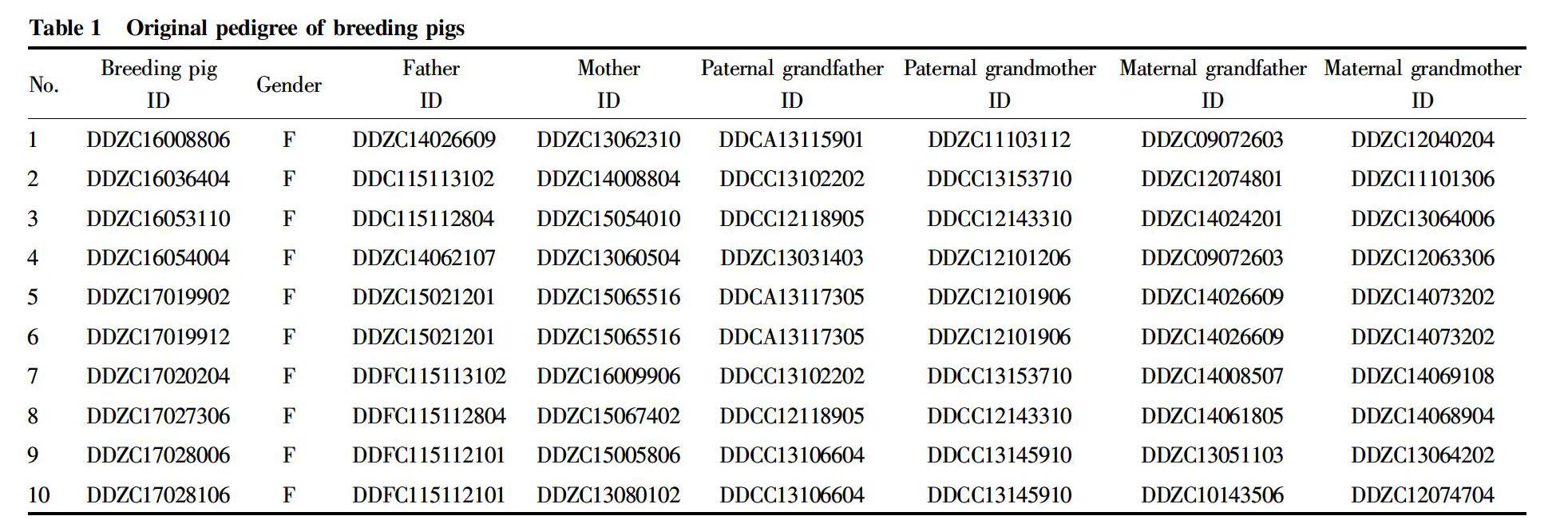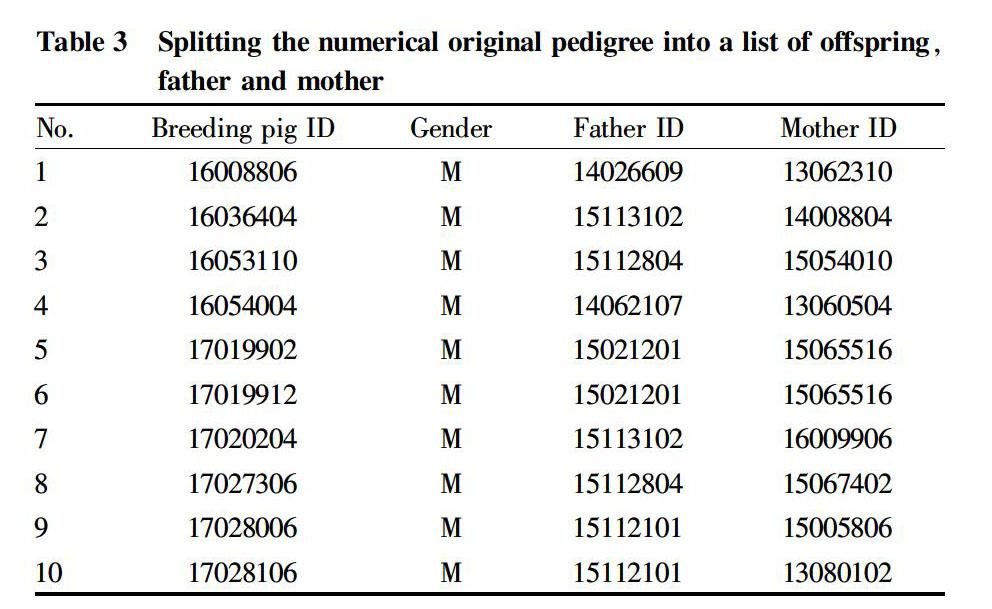Process of Analyzing Pig Inbreeding Coefficient Using SAS Program
2021-08-02XuelinFUJunyongHUYajingCHENTingtingWUWanghongLIU
Xuelin FU Junyong HU Yajing CHEN Tingting WU Wanghong LIU



Abstract The paternity index is one of the important parameters which paternity determination depends on. Inbreeding is an indispensable and effective means to improve herds and breeds and breed new strains and breeds. It can fix good traits and improve herd genetic uniformity. The INBREED module of SAS statistical analysis software can be used to calculate the inbreeding coefficients of the offspring and their parents in the pig herd pedigree. In this study, we used actual data as an example to compile and operate an SAS program for calculating the inbreeding coefficients of a pig herd. Compared with the dedicated software for calculating inbreeding coefficients developed in recent years, such as BASIC+database dBASE, Visual Basic+database SQ L Serve method, DFREMLI, MTDF EMLI, VCE, ASREML, DMU, GBS and Herdsman, calculating inbreeding coefficients with SAS programs has the advantages of low cost, simple programming language, and easy operation. For livestock breeders who are not provided with special computing software, the use of SAS to calculate the inbreeding coefficients of pigs is of great significance to planned breed selection and assortative mating.
Key words Pig herd; Inbreeding Coefficient; SAS
Received: January 11, 2021 Accepted: March 12, 2021
Xuelin FU (1982-), female, P. R. China, inspector, master, devoted to research about animal breeding.
*Corresponding author. E-mail: whliu@mail.hzau.edu.cn.
The paternity index is one of the important parameters which paternity determination depends on. Inbreeding is an indispensable and effective means to improve herds and breeds and breed new strains and breeds. It can fix good traits and improve herd genetic uniformity, while another important genetic effect of inbreeding is inbreeding depression[1]. The degree of inbreeding is generally measured by the coefficient of inbreeding. The inbreeding coefficient refers to the gene purification degree expressed in percentage based on the number of generations of inbreeding[2].
In experimental research and production practice, it is very laborious and cumbersome to manually calculate the inbreeding coefficients of individual pigs. For a long time, many researchers have devoted themselves to the design related to calculation software for pig inbreeding coefficients, for example, the design using FORTRAN[3] and BASICE[4-5] programming languages, in which all the individuals in the original genealogy must be sorted, programmed, and arranged in a predetermined order before they can be input into computers for processing. The design method using BASIC+database dBASE appeared in the later period[6], but it is necessary to use C++ language to design programming. It is quite inconvenient for operators who have no programming language foundation to use this software to calculate inbreeding coefficients. With the improvement of computer hardware and software, some researchers have designed related software based on Visual Basic[7-8], but there are no reports on the use of database systems. In addition, the Visual Basic+ database SQ L Serve method was used to design and develop calculation software for pig inbreeding coefficient. The users still need to design programming with professional C++ language to calculate the inbreeding coefficient values of pig individuals and groups in pig farms. In order to improve pig breeding and production efficiency, a series of software for breeding value estimation has been developed at home and abroad, such as DFREMLI[9], MTDF EMLI[10], VCE[11], ASREML[12] and DMU[13]. The above software is limited to genetic evaluation and the operation is more complicated. In order to facilitate the management of breeding farms, breeders have developed breeding management software for breeding farms that integrate genetic evaluation, for example, GBS[14] and Herdsman that are widely used in China. However, it is more expensive to purchase dedicated software, and the cost is as high as tens of thousands to hundreds of thousands.
In this study, the INBREED module in SAS (Statistical Analysis System) software was used to calculate the inbreeding coefficients of all individuals in a pig herd[15]. This calculation method does not require professional C++ programming language or purchasing special calculation software. It is easy to operate and calculate, and is of great significance to quick and systematic breed selection and assortative mating in livestock breeding.
Application Method of INBREED
INBREED procedure call format
The INBREED procedure call format is as follows:
PROC INBREED option;
VAR individual parent SIRE, parent DAM;
GENDER variable;
Statement description
PROC INBREED statement
The process that the statement calls the INBREED procedure was analyzed correspondingly. When calculating inbreeding coefficients, the commonly used options are: (1) IND, which is used to output the inbreeding coefficient of each individual, the value of which is equal to the value of the diagonal of the inbreeding matrix, (2) AVERGAGE, which is used to calculate the average coefficients of inbreeding of each gender and the entire group, and (3) MATRIX, which is to output the individual inbreeding coefficient matrix, in which the ith element on the diagonal in the inbreeding coefficient matrix is the inbreeding coefficient of individual i, and the element in the ith row and jth column on an off-diagonal line is the predicted inbreeding coefficient for the offspring of individual i and individual j mated.
VAR statement
There must be three variables included in the VAR statement. The first variable IND is used to store the numbers of individuals, and the second and third variables are the individuals parents SIRE and DAM, respectively. The three variables can be numerical or character, but $ needs to be added to identify characters.
GENDER statement
The GENDER statement is used to specify the gender variable of a given individual. The gender variable defaults to the characters "M" (male) and "F" (female).
INBREED Processs Requirements for Data Input Format
When using the INBREED process for analysis, the input data must be defined in advance, and the parental individuals must be placed in front of the offspring individuals. In the calculation of on-site data, they can be entered in the order of individuals birth.
Result Output
According to the different output options, the INBREED process will output the inbreeding coefficients of all individuals, and the MATRIX option will output the corresponding inbreeding coefficient matrix.
Case Study
Conversion of pig herd original pedigree
The inbreeding coefficients of 10 individuals in a herd were calculated. The original pedigree is shown in Table 1.
The pig numbers in the original pedigree were changed into the numerical format, as shown in Table 2.
All algebraic pedigrees of breeding pigs were converted into the formats of offspring, father and mother, as shown in Table 3, Table 4 and Table 5.
Calculation of inbreeding coefficients of pigs
A SAS statement was written to calculate the inbreeding coefficients of the group:
data example;
input num$ sire$ dam$;
cards;
16008806 M 1406609 13062310
16036404 M 15113102 14008804
16053110 M 15112804 15054010
…… #input data in Table 3, Table 4 and Table 5#
;
Proc inbreed ind matrix;
var num sire dam;
gender sex;
run;
SAS running results of original pedigree of the pig herd
The SAS results are shown in Table 6, Table 7 and Table 8.
It is recommended to copy the results of the SAS operation in an Excel table. When there are a large number of individuals in the pig pedigree, the "Search" function can be used to query the coefficient of inbreeding between any offspring and their parents.
Xuelin FU et al. Process of Analyzing Pig Inbreeding Coefficient Using SAS Program
References
[1] ZHAO SY, QIAO SY. Modern genetics[M]. Beijing: Higher Education Press, 2001. (in Chinese)
[2] YANG YH. General genetics[M]. Beijing: Higher Education Press, 2000. (in Chinese)
[3] LIU Y, GE YS, LU CH. Development and application of the software of pig inbreeding coefficient [J]. Animal Husbandry and Veterinary Medicine, 1984(5): 235. (in Chinese)
[4] SHI SK. BASIC language computer program for inbreeding and paternity coefficient[J]. Chinese Journal of Animal Science, 1986(4): 23-35 (in Chinese)
[5] CHEN DQ, YANG JH. Research on improving the calculation method of inbreeding coefficient of livestock and poultry[J]. Journal of Jilin Agricultural University, 1999(1): 75-77. (in Chinese)
[6] LU BR. Design of program comparing accumulating inbreeding coefficient by generation[J]. Journal of Computer Applications, 1989(2): 25-29. (in Chinese)
[7] YE Q, MENG QS, YANG YQ, et al. Social inbreeding analysis and selection system study in animal and avian[J]. Heilongjiang Animal Science and Veterinary Medicine, 2000(1): 13-14. (in Chinese)
[8] XIAO YH, YANG GH, YE Q. Development of analysis system for inbreeding degree of livestock and poultry[J]. Heilongjiang Journal of Animal Reproduction, 1999(4): 13-14. (in Chinese)
[9] MEYER K. D F R E M L: A set of program s to estimate variance components under an individual animal model[J]. J D airy Sci, l988, 71(2): 33-34.
[10] BOLDMAN KG, KRIESE LA, VAN VLECK LD, et al. A manual for use of MTDFREM L[Z]. A set of programs to obtain estimates of variances an covariances (DRAFT). Washington D C: USD A, Agric Res Service, 1995.
[11] Kovacs MA, Groeneveld E. V C E-5 users guide and reference manual[Z]. Version 5.1. Mariensee, Germany: Institute of Animal Husbandry and Animal Behavior, Federal Research Center of Agriculture, 2003: 68.
[12] GILMOUR AR, GOGEL DJ, CULLIS BR, et al. ASRem l user guide release 2.0[M] . VSN International L td., Hemel Hempstead, HPI 1ES, UK, 2006: 342.
[13] MADSEN P, JENSEN J. A users guide to DMU: A package for analyzing multivariate mixed models, version 6[M]. Denmark: Danish Institute of Agricultural Sciences, Dept. of Animal Breeding and Genetics. Research Centre Foulum. 2006: 27.
[14] XIE LH. Integrated application of new intelligent management system for original breeding pig farm[J]. China Animal Industry, 2014(5): 62-63. (in Chinese)
[15] GAO HX. SAS system SAS/STAT software user manual[M]. Beijing: China Statistical Publishing House, 1997. (in Chinese)
杂志排行
农业生物技术(英文版)的其它文章
- Anti-inflammatory Activity and Mechanism of Total Flavonoids from the Phloem of Paulownia elongate S.Y. Hu in LPS-stimulated RAW264.7 Macrophages
- Comparative Genomic Analysis of Boron Transport Gene Family in Arabidopsis and Five Crops
- Effects of Different Water-saving Irrigation Methods on Fruit Quality and Yield of Snow Melon
- Field Control Effects and Crop Safety Assessment of Triazole Fungicides on Apple Rust
- Effects of Acetylacetone Solution Soaking on Agrobacterium-transformed Maize Seed Buds
- Effects of Meteorological Factors on Overwintering Ability, Yield and Quality of Forage Rape
